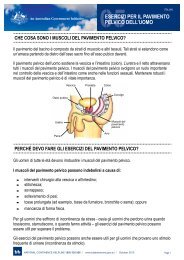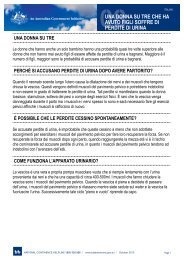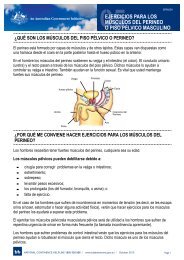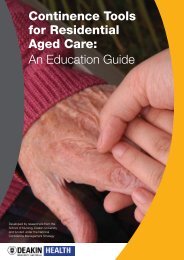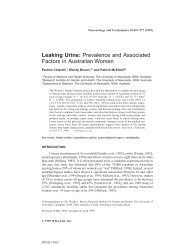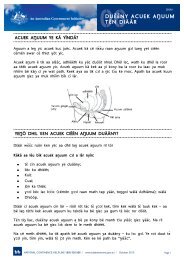Pharmacy Continence Care - Bladder and Bowel Website
Pharmacy Continence Care - Bladder and Bowel Website
Pharmacy Continence Care - Bladder and Bowel Website
You also want an ePaper? Increase the reach of your titles
YUMPU automatically turns print PDFs into web optimized ePapers that Google loves.
5 DISCUSSION<br />
5.1 Strategies for remuneration <strong>and</strong> sustainability of the service<br />
The <strong>Pharmacy</strong> <strong>Continence</strong> <strong>Care</strong> Project was developed to raise the profile of community<br />
pharmacies in continence care through community pharmacy provision of a direct advice <strong>and</strong><br />
support service to people with incontinence or caring for people with incontinence. The<br />
Program trains pharmacy staff in identifying or recognising those with or at risk of<br />
incontinence <strong>and</strong> their carers, <strong>and</strong> in providing informed advice on over-the-counter<br />
management options, medication management <strong>and</strong> access to specialist continence clinical<br />
care. The Pharmacist has a potentially significant role to play in continence care by providing<br />
ease of access to information for people with incontinence <strong>and</strong> advice on the range of<br />
strategies available for the management <strong>and</strong> treatment of incontinence.<br />
Incontinence is a common health problem, affecting more than two million Australians of all<br />
ages <strong>and</strong> backgrounds. More Australians also are affected by the condition as carers of<br />
people with urinary or faecal incontinence. One in three women experience some degree of<br />
incontinence, <strong>and</strong> the prevalence for men is estimated at between 3.1 per cent <strong>and</strong> 9 per<br />
cent. Incontinence affects up to 40 per cent of people aged over 75 years.<br />
Despite this prevalence <strong>and</strong> the considerable impacts bladder <strong>and</strong> bowel problems have on<br />
the health <strong>and</strong> wellbeing <strong>and</strong> costs of living of the individual with incontinence, their family<br />
<strong>and</strong> carers, it is estimated that less than 50 per cent of people with incontinence seek<br />
diagnosis or clinical advice <strong>and</strong> treatment. The <strong>Continence</strong> Foundation of Australian identifies<br />
international <strong>and</strong> Australian evidence that suggests 60 to 70 per cent of incontinence<br />
problems could be cured or improved through clinical <strong>and</strong> health management.<br />
There are about 5000 pharmacies in Australia <strong>and</strong> the “average” pharmacy can be estimated<br />
to see about 200 customers a day. The average daily “customer base” nationally can<br />
therefore be estimated to be about 450,000 people (men, women <strong>and</strong> children).<br />
Demographically, the “average” pharmacy customer is female, aged 50 years or more.<br />
Pharmacies are thus strategically positioned to be the most readily <strong>and</strong> commonly accessed<br />
health service provider with the capacity to promote continence awareness <strong>and</strong> to offer<br />
support <strong>and</strong>/or referral to individuals with incontinence symptoms who have not sought<br />
diagnosis, advice or treatment.<br />
The PCCP therefore is a major health service initiative with the potential significantly to raise<br />
community awareness of the issue of incontinence, to promote widespread awareness of<br />
diagnosis <strong>and</strong> treatment services, <strong>and</strong> to encourage individuals in disclosing <strong>and</strong> seeking<br />
readily accessible, appropriate <strong>and</strong> discreet information about their conditions/symptoms.<br />
The PCCP pilot has demonstrated pharmacy benefit from participation in the Program<br />
including:<br />
• The <strong>Pharmacy</strong> Survey data indicate unequivocal support for the Program.<br />
• There has been a significant increase in the confidence <strong>and</strong> perceived knowledge <strong>and</strong><br />
underst<strong>and</strong>ing of continence issues by pharmacy staff.<br />
• There is evidence of changes in pharmacy behaviour after only a brief intervention.<br />
These outcomes indicate that the Program has significant potential to become an accepted<br />
new cognitive service within pharmacy practice. This pilot has demonstrated the efficacy of<br />
the training approach <strong>and</strong> materials for pharmacy staff, in that a significant majority of<br />
Final Report<br />
47<br />
NOVA Public Policy<br />
<strong>Pharmacy</strong> <strong>Continence</strong> <strong>Care</strong> Project



